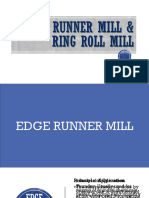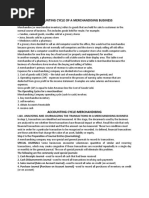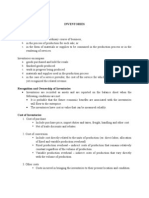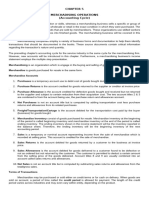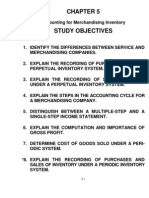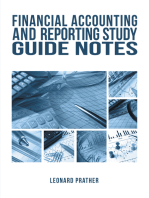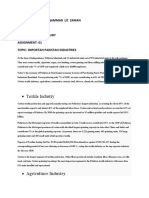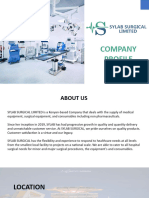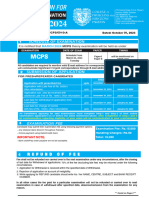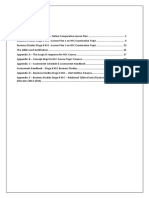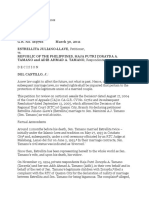0 ratings0% found this document useful (0 votes)
24 viewsChapter 5 Wiley
Chapter 5 Wiley
Uploaded by
p876468The document discusses merchandising operations and accounting for merchandising companies. It covers the differences between service and merchandising companies, purchasing and recording inventory, sales transactions including revenue recognition, and calculating profitability metrics like gross profit margin.
Copyright:
© All Rights Reserved
Available Formats
Download as PDF, TXT or read online from Scribd
Chapter 5 Wiley
Chapter 5 Wiley
Uploaded by
p8764680 ratings0% found this document useful (0 votes)
24 views28 pagesThe document discusses merchandising operations and accounting for merchandising companies. It covers the differences between service and merchandising companies, purchasing and recording inventory, sales transactions including revenue recognition, and calculating profitability metrics like gross profit margin.
Original Title
Chapter 5 Wiley PPT
Copyright
© © All Rights Reserved
Available Formats
PDF, TXT or read online from Scribd
Share this document
Did you find this document useful?
Is this content inappropriate?
The document discusses merchandising operations and accounting for merchandising companies. It covers the differences between service and merchandising companies, purchasing and recording inventory, sales transactions including revenue recognition, and calculating profitability metrics like gross profit margin.
Copyright:
© All Rights Reserved
Available Formats
Download as PDF, TXT or read online from Scribd
Download as pdf or txt
0 ratings0% found this document useful (0 votes)
24 views28 pagesChapter 5 Wiley
Chapter 5 Wiley
Uploaded by
p876468The document discusses merchandising operations and accounting for merchandising companies. It covers the differences between service and merchandising companies, purchasing and recording inventory, sales transactions including revenue recognition, and calculating profitability metrics like gross profit margin.
Copyright:
© All Rights Reserved
Available Formats
Download as PDF, TXT or read online from Scribd
Download as pdf or txt
You are on page 1of 28
ACCT 1235: Introduction to Financial
Accounting I & II
Chapter 5
Merchandising Operations
Copyright ©2020 John Wiley & Sons, Inc.
Learning Objectives
LO 1: Identify the differences between service and merchandising
companies.
LO 2: Record purchases under a perpetual inventory system.
LO 3: Record sales under a perpetual inventory system.
LO 4: Prepare a single-step and multiple-step statement of income.
LO 5: Calculate the gross profit margin and profit margin.
Differences Between Service and
Merchandising Companies
• Service companies perform services as their primary
source of revenue
• Merchandising companies buy and sell inventory (e.g.
Loblaws):
o Retailers sell to consumers
o Wholesalers sell to retailers
o Manufacturers produce goods for sale to wholesalers
or others
Operating Cycle
• The time it takes to go from cash to cash in producing
revenues
• Longer for a merchandising company than for a service
company:
o Merchandise must first be purchased
o Then it is held in stores or warehouses
o Finally sold to customers
• Adds additional steps to the operating cycle
Income Measurement Process
• Revenue:
o Revenue from the sale of merchandise is the main source.
o Simply referred to as sales.
• Expenses are divided into two categories:
o Cost of goods sold: total cost of merchandise sold in a period
o Operating expenses: incurred in the process of earning sales
• Gross profit
= Sales less cost of goods sold
Income Measurement Process for a
Merchandising Company
Inventory Systems
• Flow of costs for a merchandising company:
o Beginning inventory + cost of goods purchased = cost of
goods available for sale
o Once sold, these costs are assigned to cost of goods sold.
o Goods left over are ending inventory
• One of two systems is used to account for inventory and
cost of goods sold:
o Perpetual inventory system
o Periodic inventory system
Perpetual Inventory System
• Detailed records are kept for the cost of each product purchased
and sold
• These records are updated continuously (perpetually) for
purchases and sales
o The cost of goods sold and the reduction in inventory – both
quantity and cost – are recorded each time a sale occurs
• A physical count is done at least once a year to adjust perpetual
records to actual
• This system enables the effective control of inventory which is
an important asset
Periodic Inventory System
• Detailed records of merchandise are not kept
throughout the period
• Cost of goods sold is only determined at the end of the
accounting period:
o Once inventory is counted
o Cost of goods available for sale = beginning inventory
+ cost of goods purchased
o Cost of goods sold = cost of goods available for sale
less ending inventory
Purchases of Merchandise
• Purchases are recorded in the Inventory account
• Includes all costs to get merchandise to place of
business and ready for resale:
o Includes freight and applicable taxes
o Less purchase returns, allowances, discounts
o Total of all costs is called cost of goods purchased
• Can be made for cash or credit (on account)
Sales Taxes and Freight
• GST and HST paid does not form part of the cost of goods (as it
is refunded)
• Generally no PST on goods purchased for resale
• FOB (Free on Board) – refers to where title or ownership of
goods transfers:
o FOB destination: buyer’s place of business; seller pays for
shipping
o FOB shipping point: seller’s place of business; buyer pays for
shipping
• Freight paid by buyer (FOB shipping point) is part of the cost of
merchandise purchased
FOB Destination
Ownership of the goods does not pass from the seller to
the buyer until the goods are received by the buyer (i.e.
destination point)
FOB Shipping Point
Ownership of the goods passes from the seller to the buyer
as soon as the goods are shipped
Purchase Returns and Allowances
• A purchaser returns the goods to the seller and receives a
cash refund or credit
• The buyer may choose to keep the merchandise if the seller
is willing to give an allowance (deduction) from the
purchase price
• In both cases, the result is a decrease to the cost of goods
purchased
Discounts
• A quantity discount gives a price reduction according to
the volume of the purchase:
o Not recorded separately – discounted price is recorded as
cost of purchase
• A purchase discount is offered to encourage early
payment of a balance due. Example: 2 / 10, n 30
o Recorded separately when payment made. Results in a
decrease to Inventory account
Adjusting Entry at End of Period
• Inventory counts must be done at the end of the period
• Normally any differences result in less inventory on hand
when compared to inventory records
• This is often referred to as shrinkage and should be
investigated
• Adjustments for shortages result in a debit (increase) to C
OGS and a credit (decrease) to inventory
Summary of Purchase Transactions
Sales of Merchandise (1 of 2)
• Recording of sales (perpetual inventory system):
o Two entries required: one to record sales revenue and
one to record cost of sale
• Sales taxes are not recorded as revenue
• When freight is FOB destination, seller records cost of
freight as an operating expense
• Sales are recorded net of discount (IFRS); under ASPE,
sales discounts are a contra revenue account to Sales
Sales of Merchandise (2 of 2)
• Under IFRS, sales are recorded net of estimated
returns
• No revenue is recognized for the portion of sales for
which returns are anticipated
• A Refund Liability (deferred revenue) account is used
to track expected sales returns and allowances
• An asset account, Estimated Inventory Returns, is
used to record the cost of goods expected to be
returned
Recording Inventory Sales
Statement of Income Presentation
• Two different forms of statement of income:
o Single-step: all data classified into two categories: revenues and
expenses
o Multiple-step: shows several steps in determining net income or
loss
• Gross profit: sales less cost of goods sold
• Income from operations: gross profit less operating expenses
• Income before income tax: income from operations plus non-
operating revenues less non-operating expenses
• Net Income: income before income tax less income tax expense
Single-Step Statement of Income
Multiple-Step Statement of Income
Statement of Comprehensive Income (1 of 2)
• Presents items that are not included in determining net
income, but included in a broader measure referred to as
comprehensive income
• Examples:
o Certain gains and losses on foreign currency translation
o Unrealized gains and losses on certain types of investments
Statement of Comprehensive Income (2 of 2)
Evaluating Profitability: Gross Profit Margin
• Measures the gross profit expressed as a percentage of
sales
Gross profit
Gross profit margin =
Sales
Higher is generally better
Evaluating Profitability: Profit Margin
• Measures the percentage of each dollar of sales that
results in profit
Profit
Profit margin =
Sales
Higher is generally better
Reviewing IFRS and ASPE
Key Standard International Financial Reporting Accounting Standards for Private Enterprises (ASPE)
Differences Standards (IFRS)
Revenue recognition Uses the contract-based approach, which uses Uses the earnings-based approach, which enables
a five-step model for determining when a revenue to be recognized when the goods or services
company has satisfied a performance have been provided, the amount is measurable, and
obligation and can recognize revenue. collection is reasonably assured.
Accounting for sales These are considered to be variable The full amount of the selling price is normally
discounts consideration. The transaction price is reduced recognized at the time of sale. When sales discounts are
by the expected sales discounts. taken by customers, a contra revenue account is used to
account for them.
Accounting for sales These are considered to be variable The full amount of the selling price is normally
returns and consideration. The transaction price is reduced recognized at the time of sale. When sales returns and
allowances by the expected sales returns and allowances. allowances are granted, a contra revenue account is used
A refund liability is established for these to account for them.
amounts.
Statement of income Expenses must be classified by nature or by Expenses can be classified in any manner the company
function. finds useful.
Statement of A statement that presents the sum of net There is no requirement to revalue any assets or
comprehensive income and other comprehensive income. liabilities to fair value at the end of each reporting period.
income Unrealized gains and losses that are not As a result, there are no unrealized gains and losses and,
included in net income are included in therefore, no other comprehensive income and no need
comprehensive income. for this statement.
You might also like
- Spa - Back Pay - TamayoDocument1 pageSpa - Back Pay - TamayoDeil L. NaveaNo ratings yet
- Accounting Cycle of A Merchandising BusinessDocument54 pagesAccounting Cycle of A Merchandising BusinessKim Flores100% (2)
- Financial Aspects in RetailDocument31 pagesFinancial Aspects in RetailPink100% (4)
- Basics of Piping EngineeringDocument43 pagesBasics of Piping EngineeringAyush100% (1)
- Edge Runner Mill & Ring Roll MillDocument7 pagesEdge Runner Mill & Ring Roll MillBea UyNo ratings yet
- Accounting Chapter 5Document14 pagesAccounting Chapter 5lochcarlNo ratings yet
- Chapter 5 (Appendix Included)Document12 pagesChapter 5 (Appendix Included)Hareem Zoya WarsiNo ratings yet
- Accounting Principles: Second Canadian EditionDocument36 pagesAccounting Principles: Second Canadian EditionMelody YayongNo ratings yet
- Statement of Comprehensive IncomeDocument30 pagesStatement of Comprehensive Incomemaligaya evelyn100% (1)
- Notes - Accounting Cycle of A Merchandising CompanyDocument10 pagesNotes - Accounting Cycle of A Merchandising CompanyRoanne Mae Canedo-PelorianaNo ratings yet
- ACCT 101 Chapter 4 HandoutDocument5 pagesACCT 101 Chapter 4 Handoutchienna.mercadoNo ratings yet
- IA 1 - Chapter 10 - ReviewerDocument4 pagesIA 1 - Chapter 10 - Reviewerkimingyuse1010No ratings yet
- Accounting Cycle of Merchandising BusinessDocument42 pagesAccounting Cycle of Merchandising BusinessAiron P. VispoNo ratings yet
- Inventory Lecture NotesDocument15 pagesInventory Lecture NotessibivjohnNo ratings yet
- Describe Merchandising Operations and Inventory SystemsDocument4 pagesDescribe Merchandising Operations and Inventory SystemsSadia RahmanNo ratings yet
- Chapter 6 Financial StrategyDocument5 pagesChapter 6 Financial StrategySweta KumariNo ratings yet
- Chapter 6 PowerpointDocument34 pagesChapter 6 Powerpointapi-248607804No ratings yet
- Chapter 7Document6 pagesChapter 7Pranshu GuptaNo ratings yet
- A Presentation On: Accounting For Merchandising OperationDocument26 pagesA Presentation On: Accounting For Merchandising OperationKayesCjNo ratings yet
- Resume CH 5 IFRSDocument6 pagesResume CH 5 IFRSDeswita CeisiNo ratings yet
- Retama - Chapter 8Document53 pagesRetama - Chapter 8geo023No ratings yet
- Unit 4Document85 pagesUnit 4Ankush Singh100% (1)
- Foa-I Ch-3 For Bais and LSCMDocument38 pagesFoa-I Ch-3 For Bais and LSCMAbdulhamid AbdulsemedNo ratings yet
- Accounting For Merchandising BusinessDocument20 pagesAccounting For Merchandising BusinessJen RossNo ratings yet
- Accounting For Merchandising OperationsDocument13 pagesAccounting For Merchandising OperationsAB Cloyd100% (1)
- Paniqui SciDocument27 pagesPaniqui Scival floresNo ratings yet
- CH03Document50 pagesCH03Hesly Irawanda NaibahoNo ratings yet
- ACT 110 MerchandisingDocument17 pagesACT 110 Merchandisingmohammadnaim.jl181No ratings yet
- Session 5 and 6 PDFDocument32 pagesSession 5 and 6 PDFmilepnNo ratings yet
- Fabm NATURE OF MERCHANDISING BUSINESSDocument1 pageFabm NATURE OF MERCHANDISING BUSINESSPhegiel Honculada MagamayNo ratings yet
- Operating Cycle of A Merchandising BusinessDocument10 pagesOperating Cycle of A Merchandising BusinessJanelle FortesNo ratings yet
- PPT on SCI.student's CopyDocument62 pagesPPT on SCI.student's CopyJasmine Aem TingsonNo ratings yet
- Statement of Comprehensive IncomeDocument25 pagesStatement of Comprehensive IncomeAngel Nichole ValenciaNo ratings yet
- Accounting 101Document25 pagesAccounting 101dalpra.m04No ratings yet
- Session 6 Merchandising 1Document60 pagesSession 6 Merchandising 1Jo-Al Gealon100% (1)
- WK 3 - 4thQtr - Fundamentals of ABM 1 Module and LAS v2Document4 pagesWK 3 - 4thQtr - Fundamentals of ABM 1 Module and LAS v2Hanna mariel Del MundoNo ratings yet
- FE1 Chapter 3Document40 pagesFE1 Chapter 3Hùng PhanNo ratings yet
- FABM 1 - Contextualized LAS - Quarter 2 - Week 2Document7 pagesFABM 1 - Contextualized LAS - Quarter 2 - Week 2Sheila Marie Ann Magcalas-GaluraNo ratings yet
- Inventories (Ias 2)Document16 pagesInventories (Ias 2)Corinne GohocNo ratings yet
- AccountingDocument8 pagesAccountingShafqat WassanNo ratings yet
- Acc-4(1)Document23 pagesAcc-4(1)masum.du14001No ratings yet
- Inventory SystemsDocument18 pagesInventory SystemsJuliana Silver Marie M. Apolto100% (1)
- Chapter 5 PowerpointDocument37 pagesChapter 5 Powerpointapi-248607804No ratings yet
- Chapter 4Document6 pagesChapter 4Sagar BeheraNo ratings yet
- Chapter 6 WileyDocument23 pagesChapter 6 Wileyp876468No ratings yet
- Chapter 3 Fundamental iDocument42 pagesChapter 3 Fundamental ioronew0No ratings yet
- Financial Accounting - Information For Decisions - Session 4 - Chapter 6 PPT bDrohULB9YDocument36 pagesFinancial Accounting - Information For Decisions - Session 4 - Chapter 6 PPT bDrohULB9Ymukul3087_305865623No ratings yet
- P2 Notes MerchandisingDocument14 pagesP2 Notes Merchandisingchen.abellar.swuNo ratings yet
- FABM 2 Lesson 1 2 3 4 5 SummaryDocument16 pagesFABM 2 Lesson 1 2 3 4 5 SummaryGelai BatadNo ratings yet
- InventoryDocument7 pagesInventoryPNo ratings yet
- CH2 Fabm2Document27 pagesCH2 Fabm2Crisson FermalinoNo ratings yet
- Sequence 3Document5 pagesSequence 3djer2182No ratings yet
- Chapter 6.merchandizing Activities - KSBLDocument22 pagesChapter 6.merchandizing Activities - KSBLSohail AusafNo ratings yet
- Periodic PerpetualDocument25 pagesPeriodic PerpetualNunung Nurul100% (1)
- AAC Principle 2 CH 1Document37 pagesAAC Principle 2 CH 1fhagos003No ratings yet
- Revenue and Expense RecognitionDocument27 pagesRevenue and Expense RecognitioncskNo ratings yet
- Chapter 5. Accounting For Merchandising OperationsDocument5 pagesChapter 5. Accounting For Merchandising OperationsÁlvaro Vacas González de EchávarriNo ratings yet
- Financial StatementsDocument12 pagesFinancial StatementsShrutika MoreNo ratings yet
- AssignmentDocument3 pagesAssignmentSyed InthiyazNo ratings yet
- CPA Chapter 4 FAR Notes Inventories & CA/CLDocument5 pagesCPA Chapter 4 FAR Notes Inventories & CA/CLjklein2588No ratings yet
- Chapter 5 - 6 - Inventory Accounting and ValuationDocument61 pagesChapter 5 - 6 - Inventory Accounting and ValuationNaeemullah baig100% (1)
- Week 2 - Fabm 1 - Accounting Cycle of A Merchandising BusinessDocument19 pagesWeek 2 - Fabm 1 - Accounting Cycle of A Merchandising BusinessSheila Marie Ann Magcalas-Galura100% (1)
- Financial Accounting and Reporting Study Guide NotesFrom EverandFinancial Accounting and Reporting Study Guide NotesRating: 1 out of 5 stars1/5 (1)
- Working Method For Piping Installation - Add Method For Boom Lift 227KgDocument58 pagesWorking Method For Piping Installation - Add Method For Boom Lift 227KgPhát NguyễnNo ratings yet
- Individual Assignment 1 Cost IIDocument6 pagesIndividual Assignment 1 Cost IIhailegebreselassie24No ratings yet
- PST AssignmentDocument5 pagesPST AssignmentsohaibNo ratings yet
- Unit 5Document70 pagesUnit 5gowrishankar nayanaNo ratings yet
- Shapta Uce Agriculture P2 2024 4Document4 pagesShapta Uce Agriculture P2 2024 4buuleivan8100% (1)
- Assignment 2 Front Sheet: Qualification BTEC Level 5 HND Diploma in ComputingDocument40 pagesAssignment 2 Front Sheet: Qualification BTEC Level 5 HND Diploma in ComputingDũng Hoàng TiếnNo ratings yet
- Washing Machine: User ManualDocument112 pagesWashing Machine: User Manualmmm1018No ratings yet
- Sylab Presentation 1Document12 pagesSylab Presentation 1stanleyongaga75No ratings yet
- Simple Guide To EADocument6 pagesSimple Guide To EAmarcelinoplaceresNo ratings yet
- Mcps March 24Document3 pagesMcps March 24azeemjoiya4No ratings yet
- Organization Culture ProjetDocument92 pagesOrganization Culture ProjetVenkata Siva ReddyNo ratings yet
- MOHAMED S. ITOWALA V VARIETY BUREAU DE CHANGEDocument4 pagesMOHAMED S. ITOWALA V VARIETY BUREAU DE CHANGEvalentinaNo ratings yet
- (INGCO) 06 Juli 2024 Stock Report NewDocument21 pages(INGCO) 06 Juli 2024 Stock Report Newmragung361No ratings yet
- Brothers Anthony and Christopher Gaber Began Operations of Their ToolDocument1 pageBrothers Anthony and Christopher Gaber Began Operations of Their Toolhassan taimourNo ratings yet
- The Mindsets and Practices of ExcellentDocument14 pagesThe Mindsets and Practices of ExcellentManuel Arriola Gomar100% (1)
- Mba Operations NotesDocument6 pagesMba Operations NotesRajeev Kumar PandeyNo ratings yet
- 02 - I500 - Product IntroductionDocument48 pages02 - I500 - Product Introductionmikifit1No ratings yet
- 19 024Document6 pages19 024vincent02hk_57881301No ratings yet
- Full Stress Management Research PaperDocument12 pagesFull Stress Management Research Paper903398688167% (3)
- Grand Designs UK - August 2023Document132 pagesGrand Designs UK - August 2023ธนวัฒน์ ปิยะวิสุทธิกุล100% (1)
- Ex Parte MilliganDocument2 pagesEx Parte Milligancatrina lobatonNo ratings yet
- GenDocument4 pagesGenBALACHITRANo ratings yet
- Assignment 2 - Secondary Curriculum 2a Business Studies-MustaphaDocument51 pagesAssignment 2 - Secondary Curriculum 2a Business Studies-Mustaphaapi-327720466No ratings yet
- Improvement of Sangguniang Kabataan Programs in Barangay Quiniput, Curuan, and BuenavistaDocument7 pagesImprovement of Sangguniang Kabataan Programs in Barangay Quiniput, Curuan, and BuenavistaXanthophile Shopee100% (1)
- By:-Devang Gangwani and Ashish Juriani - Final Year Bpharm (2018)Document20 pagesBy:-Devang Gangwani and Ashish Juriani - Final Year Bpharm (2018)Devang GangwaniNo ratings yet
- 21 1 ProctorDocument4 pages21 1 Proctormamadreza.on.targetNo ratings yet
- G.R. No. 169766 March 30 2011 Juliano Llave CaseDocument17 pagesG.R. No. 169766 March 30 2011 Juliano Llave CaseMarcial SiarzaNo ratings yet




